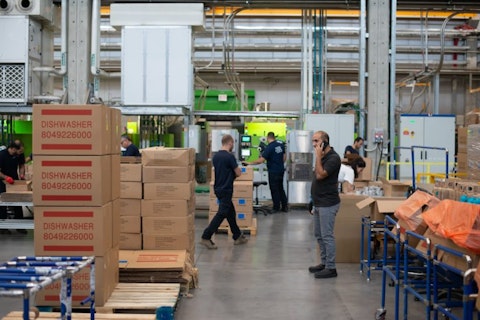W.W. Grainger, Inc. (NYSE:GWW) Q4 2022 Earnings Call Transcript February 2, 2023
Operator: Greetings, and welcome to the W.W. Grainger Fourth Quarter and Full Year 2022 Earnings Call. At this time, all participants are in a listen-only mode. A question-and-answer session will follow the formal presentation. Please note that this conference is being recorded. I will now turn the conference over to our host, Kyle Bland, Vice President of Investor Relations. Thank you. You may begin.
Kyle Bland: Good morning. Welcome to Grainger’s fourth quarter and full year 2022 earnings call. With me are D.G. Macpherson, Chairman and CEO; and Dee Merriwether, Senior Vice President and CFO. As a reminder, some of our comments today may include forward-looking statements. Actual results may differ materially as a result of various risks and uncertainties, including those detailed in our SEC filings. Reconciliations of any non-GAAP financial measures with their corresponding GAAP measures are found in the tables at the end of this presentation and in our Q4 earnings release, both of which are available on our Investor Relations website. This morning’s call will focus on fourth quarter and full year 2022 adjusted results, which exclude the gain related to the divestiture of Cromwell’s enterprise software business, which was sold in the fourth quarter.
We will also share results related to MonotaRO. Please remember that MonotaRO was a public company and follows Japanese GAAP, which differs from U.S. GAAP and is reported in our results 1 month in arrears. As a result, the numbers disclosed will differ somewhat from MonotaRO’s public statements. Now I’ll turn it over to D.G.
D.G. Macpherson: Thanks, Kyle. Good morning and thank you for joining us today. I’m going to discuss some of our key accomplishments from 2022, and then I’ll pass it to Dee to walk through the specifics of our fourth quarter performance and our outlook for 2023. Turning to Slide 4. The Grainger Edge framework has been instrumental in guiding our work in 2022. We know that when we live our principles, focus on the things that matter and serve our customers well, we can achieve great things. Our customer base is very broad. I’ve been with customers that are seeing positive economic signs like aerospace, and I’ve also been with other customers like some retailers that are seeing some concerning economic signs. But in general, our customers continue to be busy, and Grainger has and will remain the trusted partner of providing value to their operations every day.
As we look to 2023 and beyond, we are excited to continue living out the Grainger Edge starting with the customer and serving as their valued partner through any cycle. In 2022, the Grainger team stayed relentlessly focused on what matters most, providing our customers exceptional service, supporting each other and making a positive impact on our communities and the environment. In both models, we made strategic investments to support customers and build the business for the future. This included adding supply chain capacity, including a new bulk warehouse in the U.S. and the start-up of the Anegawa distribution center in Japan, expanding our digital and data capabilities, including progress with our customer and product information systems, in our high-touch business and improved account management tools and our endless assortment model, and executing against our merchandising and marketing initiatives, including temp search and recommendation functionality.
During the year, we also continued to strengthen our purpose-driven culture by ensuring Grainger is a place where our team members can be their true cells and have a fulfilling career. We continue to receive external recognition for our workplace culture. But what means the most to me and the rest of the leadership team is the positive feedback from team members about why they choose to build their career at Grainger. And finally, we continue to make progress with our environmental, social and governance objectives, both internally and in supporting our customers to help them achieve their own ESG goals. The result of this focus was an outstanding year of profitable growth, and we are extremely proud of our results, which surpassed our own expectations throughout the year.
Turning to Slide 6. We finished the year with over $15.2 billion in sales, up 16.5% on a daily basis or 19.3% in daily constant currency as demand across the business remains strong. In our high-touch business in North America, we focused on our growth engines and achieved approximately 775 basis points of U.S. market outgrowth in 2022, far exceeding our updated target of 400 to 500 basis points. In the endless assortment model, both Zoro and MonotaRO made progress to achieve high-teens growth in local currency and local days. During the year, we drove 215 basis points of gross margin improvement, which, when coupled with 40 basis points of SG&A leverage resulted in 255 basis points of operating margin expansion and a nearly 50% increase in adjusted EPS.
We also generated over $1.3 billion in operating cash flow, an increase of 42% over 2021 and returned $949 million to Grainger shareholders through dividends and share repurchases. We accomplished this while also improving our ROIC by 870 basis points to 40.6%. The strong 2022 financials were the result of staying focused throughout the year on what truly matters to our customers, our suppliers and our team members, and we are well positioned to continue this momentum into 2023. With that, I will turn it over to Dee to discuss the details of the fourth quarter and our outlook.
Dee Merriwether: Thanks, D.G. Turning to our fourth quarter 2022 results for the total company, it was a solid quarter to finish out this year. And while you’ll notice some noise as we walk through the financials, at the end of the day, we delivered great results. Sales growth in the quarter was 13.2% or 17.2% on a daily constant currency basis, which normalizes for the impact of the depreciating yen. Our results this quarter included strong growth in both segments as we continue to execute well against our strategic priorities. This includes approximately 800 basis points of share gain in the U.S. high-touch business and high-teens growth in local currency across endless assortment. Total company gross profit margin in the quarter was 39.6%, expanding 230 basis points over the prior year fourth quarter driven by increases in both segments and including a favorable year-over-year impact from year-end inventory adjustments, which I’ll detail in a moment.
The strong gross margin performance was partially offset by a decrease in SG&A leverage in the quarter. We continue to invest in our strategic initiatives and also incurred an aggregate $35 million in non-recurring items in the quarter. This includes a one-time bonus to most hourly employees within high touch to recognize their significant contributions towards our 2022 performance. Excluding these one-time non-recurring items, total company SG&A as a percentage of sales would have been roughly flat year-over-year. Despite these non-recurring costs, we still finished the quarter with operating margin up 135 basis points over the prior year period. This profitable growth resulted in diluted EPS of $7.14 for the fourth quarter, representing a 31% increase versus the fourth quarter 2021, another strong quarter of performance.
In our High-Touch Solutions segment, we continue to see strong growth with daily sales up 16.8% compared to the fourth quarter of 2021. We saw continued positive growth in all major customer end markets across the segment, including over 20% growth in natural resources, transportation and heavy manufacturing. The daily sales increase in the U.S. of over 17% was fueled by mid-single-digit volume growth and continued strong price realization of over 11% in the quarter. Canadian daily sales were also strong, up 7% or 17.2% in local days in local currency. For the segment, GP margin finished the quarter at 41.9%, achieving 225 basis points of margin expansion. During the quarter, the segment benefited from lower freight costs and continued improvement in product mix.
Margin was also favorably impacted by year-end inventory adjustments as we lap the unfavorable LIFO adjustment from the prior year period and also recorded a positive net inventory adjustment in the current year period. The net impact of these inventory adjustments was around 130 basis points for the segment. Price/cost spread in the quarter was also roughly neutral. Moving to SG&A. The segment delevered by about 35 basis points, which was driven by continued investments in marketing and headcount to support growth. In addition, the segment incurred $29 million in non-recurring items in the period, including the one-time bonus payment previously discussed and some accounting true-ups to close the year. While we did modestly delever SG&A, we still expanded operating margins by 190 basis points year-over-year, finishing with a 15.5% operating margin for the segment.
This is a strong finish for our High-Touch team. Looking at market outgrowth on Slide 10, we estimate that the U.S. MRO market, including volume and price inflation, grew between 9% and 10%, implying we outpaced the market by roughly 800 basis points in the quarter. This strong finish helped us deliver 775 basis points of market outgrowth for the full year 2022. We continue to have great success in gaining share as we execute against our strategic growth engines in our High-Touch model. We remain confident in our ability to deliver the 400 to 500 basis points of annual outgrowth going forward and are excited to continue partnering with our customers and our suppliers to drive value for all parties each and every day. Moving to our Endless Assortment segment, reported and daily sales increased 0.9% or 18.2% on a daily constant currency basis after normalizing for the significant impact of the depreciating yen.
In local currency and local days, MonotaRO achieved 19.4% growth and Zoro U.S. was up 19.5%. Revenue growth continues to be driven by strong new customer acquisition and repeat business for the segment as well as enterprise customer growth at MonotaRO. Gross margin for this segment expanded 170 basis points versus the fourth quarter of 2022 as we saw strong price realization, coupled with continued freight efficiencies as average order values have increased year-over-year. We also benefited from favorable business unit mix as Zoro grew faster than MonotaRO in the quarter. Segment operating margin declined 180 basis points as favorable gross margin was more than offset by heightened SG&A costs. While Zoro’s operating margins were roughly flat in the quarter, MonotaRO was impacted by start-up costs at the new Anegawa DC as well as non-recurring asset retirement costs related to the upcoming closure of the Amagasaki facility.
As we lap the DC transition costs and ramp a new facility to peak efficiency, we expect profitability will begin trending towards more normal levels as we move through 2023. On Slide 12, we continue to see positive results with our key Endless Assortment operating metrics. Total registered users are tracking nicely with Zoro and MonotaRO combined, up 17% over the prior year. On the right, we show the continued growth of Zoro SKU portfolio, now at over 11 million SKUs. And in 2022, the team successfully delivered on our stated goal to add 2 million SKUs per year over the next several years. In summary, a great job of spending the Endless Assortment flywheel by both Zoro and MonotaRO in 2022. I also want to acknowledge the exciting news that our Zoro U.S. business surpassed $1 billion in annual sales in 2022, the first time they exceeded that threshold in their history.
It’s been an amazing success story since we launched this business back in 2011, and we remain excited about what Masaya, Kevin and the rest of the Zoro team will accomplish going forward. Moving to our outlook. Despite the economic uncertainty heading into 2023, our high-level earnings algorithm remains intact. Within our High-Touch segment, over the longer-term economic cycle, we target growing 400 to 500 basis points faster than the U.S. MRO market and remain confident in our ability to do so. In our Endless Assortment segment, we expect to continue our track record of strong growth, both in the U.S. and in Japan. At the total company level, we target generally stable gross margin performance over time while sticking to our core pricing tenant, and as we strive to grow SG&A slower than sales to help expand operating margin.

Photo by Remy Gieling on Unsplash
Couple this with our balanced and consistent approach to capital allocation, and we can drive attractive returns over the long term as we’ve done especially well over the last few years. So what does this mean for 2023? At the total company, we expect revenue between $16.2 billion and $16.8 billion, with daily sales growth between 7% and 11%, driven by strong top line performance in both segments. Note that this range is 40 basis points lower on a reported basis when factoring in one less selling day in 2023. Within our High-Touch Solutions segment, we expect daily sales growth between 5% and 9.5%. In the U.S., we’re planning for MRO market growth between 1% and 5%, comprised of a volume range of flat to down 3% coupled with price inflation between 4% and 5%, largely representing the wrap of 2022 price increases.
On top of a 1% to 5% market, we expect to continue executing against our strategic growth engines to achieve 400 to 500 basis points of U.S. market outgrowth in 2023. In the Endless Assortment segment, we anticipate daily sales to grow between 16% and 18% or roughly 17% to 19% in daily constant currency when factoring in 100 basis points of foreign exchange headwind at the segment level from the Japanese yen. Zoro is anticipated to grow within the segment range, reflecting further SKU expansion and a continued focus on acquiring and retaining high-value business customers. MonotaRO is also expected to grow within the segment range and local currency as they continue to grow with both small businesses and large enterprise customers. Moving to our margin expectations.
We expect strong performance in both segments with stable to expanding performance in High-Touch Solutions and improving profitability in Endless Assortment. In the High-Touch Solutions segment, we expect gross profit in the year to be flat to slightly down as we anticipate some of the price/cost favorability experienced in 2022 to unwind as we trend back to neutrality over the long term. We expect this headwind will be partially offset by freight favorability given the improvement in container cost and the current outlook for diesel prices. On the SG&A side, we will continue to make incremental investments toward our strategic initiatives as we fuel our growth algorithm. We will also have some tailwinds as we lap the non-recurring items that hit in the fourth quarter and a certain expenses like variable compensation reset in the new year.
Overall, in total, we expect SG&A leverage to be favorable, and therefore, when combined with our top line growth expectations, we anticipate operating margin of 16.3% to 16.8% in High-Touch for 2023. In the Endless Assortment segment, we expect MonotaRO’s operating margins to improve year-over-year as they continue to benefit from favorable freight efficiencies and strong price realization. At Zoro, we expect operating margins to continue to ramp as they gain leverage on their cost base. Overall, this represents operating margin for the segment between 8.6% and 9%, an improvement of 60 to 100 basis points compared to 2022. Growing this up for total company, we expect to gain SG&A leverage of 30 to 60 basis points to offset a modest decline in gross margin, resulting in operating margin between 14.4% and 14.9% for the full year.
Turning now to capital allocation, we expect the business will continue to generate strong cash flow in the year with an expected range of $1.45 billion to $1.65 billion, an increase of over $215 million at the midpoint compared to 2022. We expect to use this cash to invest in the business and return capital to shareholders. As discussed at our Investor Day in September, we plan to invest in our DC network over the next few years to support strong growth and to maintain industry-leading service levels. With this, we anticipate capital spending in the range of $450 million to $525 million in 2023. This includes DC capacity investments to expand our service advantage in the U.S. as well as the start of a new DC project in Tokyo. We are also continuing to invest in technology to further our customer and product information advantage and we’ll continue spending on accretive ESG investment across the portfolio.
We expect to continue to return a significant amount of cash to shareholders in line with our historical approach. This will include share repurchases to the tune of $550 million to $700 million and a strong cash dividend, which we’ve increased consistently for the past 51 years and expect to do so again here in 2023. Summarizing the high-level points on Slide 17, you can see these revenue, profitability and capital allocation expectations translate to adjusted EPS of $32 to $34.50 per share, a 7.9 to 16.3 percentage increase over 2022, and nearly double our pre-pandemic 2019 adjusted EPS of $17.29. We are off to a really strong start in January with preliminary total company daily sales of 16% or around 19% in daily constant currency. We do expect growth rates will be stronger in the first half as results will benefit from a more pronounced price wrap.
In the second half, we will face tougher comps and have modeled a slower economic cycle. On profitability, while every year is different, we do expect gross margins will generally follow our traditional seasonal pattern with a high water mark in the first quarter and sequential declines in the second and third quarters. We anticipate SG&A will be reasonably consistent over the course of the year. With that, I’ll turn it back to D.G. for some closing remarks.
D.G. Macpherson: Thank you, Dee. Before I open it up for questions, I want to first and foremost, thank the Grainger team as well as our customers and supplier partners who have helped to drive such a successful year. We truly kept the world working in 2022 and in turn achieved outstanding results for the year, both financially and operationally. I am excited for what is to come in 2023 and remain confident in Grainger’s ability to create tangible value, the liver follows experience to drive profitable growth over the long haul. With our team’s continued commitment to focusing on the things that matter, we are well poised to deliver in any macro environment. With that, we will open up the line for questions.
See also 15 Most Undervalued Quality Stocks To Buy and World’s Most Valuable Private Companies.
Q&A Session
Follow W.w. Grainger Inc. (NYSE:GWW)
Follow W.w. Grainger Inc. (NYSE:GWW)
Operator: Thank you. And at this time, we will conduct a question-and-answer session. Please limit yourself to one question and one follow-up question. Our first question comes from Tommy Moll with Stephens. Please state your question.
Tommy Moll: I’ll ask two, both on High-Touch. Let’s start on pricing there. It looks like for 2023, four to five points of growth on price. Dee, I think you heard — I think I heard you say that most, but maybe not all of that is a wrap, but if you could comment there on the wrap versus any new initiatives? And then also just a related point, are there any areas of pricing pressure? That’s something that’s been picked up in the marketplace this quarter elsewhere. And I just wonder if you’ve seen any of that in your business.
Dee Merriwether: So I’ll start with the first part and then maybe D.G. can add in a little bit on what he’s hearing from — what he’s hearing from some customers on the visit. So, yes, when we look at the market outlook, it includes both price and volume. And so the sum of that, we believe, will be somewhere in the range of 1% to 5% of the total market. We believe that volume will be down 3% to flat. And as you know, at price, up 4% to up 5%, we have more visibility into our pricing than anyone. And so when we look at price, we are also taking into account our wrap, which is basically the price increases that we took in 2022 and their full impact to 2023. So, we still see a little bit more price coming our way. So, it takes that three-ish percent up to about 4% to 5% from for the price outlook.
D.G. Macpherson: Yes. Tommy, I would say most of the — if there’s deflationary pressure, it’s mostly due to commodities. So there are — we have — we’ve taken prices up and down across the assortment and the ones that are down are almost always very commodity intensive. So they’re very steel-intensive or very — some specific commodity intensive. So, we do see — we do see that broad market pressure. We don’t see that much. It’s more specific commodities that we’re seeing right now.
Tommy Moll: That’s helpful. And then I wanted to follow up on the volume — the volume outlook for High-Touch flat to down three. And D.G., you mentioned at least one area of strength in aero and one area of relative weakness in retail. But I’m just curious, as you roll it all up into that full year outlook, are there other areas of weakness you’re already seeing? Or is it more just potentially some conservatism around the back half? Anything you could provide there would be helpful.
D.G. Macpherson: Yes. We’re really sticking to what the market projections are at this point. In terms of — you heard the January results. We aren’t seeing a lot of weakness to be fair at this point. We do expect in the back half, there to be more challenges from a volume perspective. What I would say is every customer we have has a COVID-fueled story about what’s happened to their volume over the past few years and where they’ve been determines whether they’re facing pressures now or whether they’re seeing optimism. So obviously, with aerospace, they — we shut down the airlines for a long time and they now have orders. So they’re starting to build up. And that’s going to take a couple more years to actually get the full speed, we think, with aerospace.
With some, they may have forward loaded some of their volume because they were selling things that were very important during the pandemic, and now they’re faced with situations where things are slowing down. So, I would say every customer has their own story, net-net, that we’re not seeing any real softness as of yet, and that’s showing in the numbers.
Operator: Our next question comes from Ryan Merkel of William Blair. Please state your question.
Ryan Merkel: Nice quarter. I wanted to start with a couple of questions on price cost. Just wanted to dig in a little bit more. So last quarter, I think price cost held by 60 basis points. And then in the fourth quarter, it was flat. I’m just curious, why does it move around so much. And then I think you’re managing the price cost being neutral. But typically in the past, when there’s a lot of inflation, right, your gross margins would expand. I’m curious how you’re sort of managing to that price cost neutral.
Dee Merriwether: Well, if you’re specifically focused on GP in the U.S., our gross margins have expanded, if you look over a longer period of time here. And as it relates to price cost, just want to reiterate, when we talk about neutrality, we do talk about that over time. And we have continued to speak about the fact that price cost just like GP is lumpy. We have a cost cycle, which we have traditionally had for years that really didn’t hold last year because of how fast cost inflation was coming in to suppliers. So that makes the cost piece of that a little bit lumpier. And then if you recall, we have the opportunity based upon our percentage of revenue, highly contracted. We have the right to introduce price at different periods during the time.
We also have web price, which is also a good portion of our business, and we can pass price on web at any particular time. So that is the lumpiness. It’s the timing of when we can actually price plus the timing of when cost actually comes through. And that’s why our focus is doing that over a period of time and when it makes sense, both for our supply base as well as for our customer base.
Ryan Merkel: Okay. That makes sense. And then my follow-up, I think you had 9% price mix in ’22. And my question is, is that 9% also included in your definition of the MRO market? And really what I’m getting at is, did Grainger have more price in ’22 than the market? And if so, why?
D.G. Macpherson: Yes. Maybe I’ll cover that. First of all, I think that the way you measure price inflation is probably not common across everybody. So you dive into the details that we don’t really know how others are talking about price inflation, so we wouldn’t comment on that. I think the thing I would point to is, to Dee’s point, we generally think of price as pricing to the market, and we are very confident that what we have now is market competitive, and we look at that very, very, very closely, given our history, you might understand why we would do that. And so we are more wired on how we price competitive. As you said, there’s really a lot of lumpiness. We may have taken price later than others or some may have taken earlier who knows. But the reality is that we are very competitive now and feel like we’re in a good position on pricing.
Operator: Our next question comes from Deane Dray with RBC Capital Markets. Please state your question.
Deane Dray: Could we touch on freight for a second? It looked like that rate efficiencies helped you on price cost, if I read that correctly, but it still sounds like there’s freight inflation. So where does that stand today?
D.G. Macpherson: Yes. So our price cost does not include freight the way we define it for you. So freight is a separate issue. Obviously, we consider freight in everything we do. Like everybody, we saw huge freight increases during 2021 and 2022. That has certainly moderated. It’s still above 2019 levels fairly substantially, but we have seen that come down quite a bit. So — and we talked about for this year, we expect it to be a benefit in terms of some of the moderating prices. And some of that is sort of obvious places the containers from overseas or a lot cheaper than they were six months ago, quite a bit. They’re still relatively higher than 2019, but getting closer. Other parts of the market are still tight. So net-net, we still feel like it will be a small benefit this year for sure.
Deane Dray: That’s helpful. And then a follow-up on the supply chain. Just where does it stand today in efficiencies? What kind of lead times are you seeing and expectations about returning to normal?





